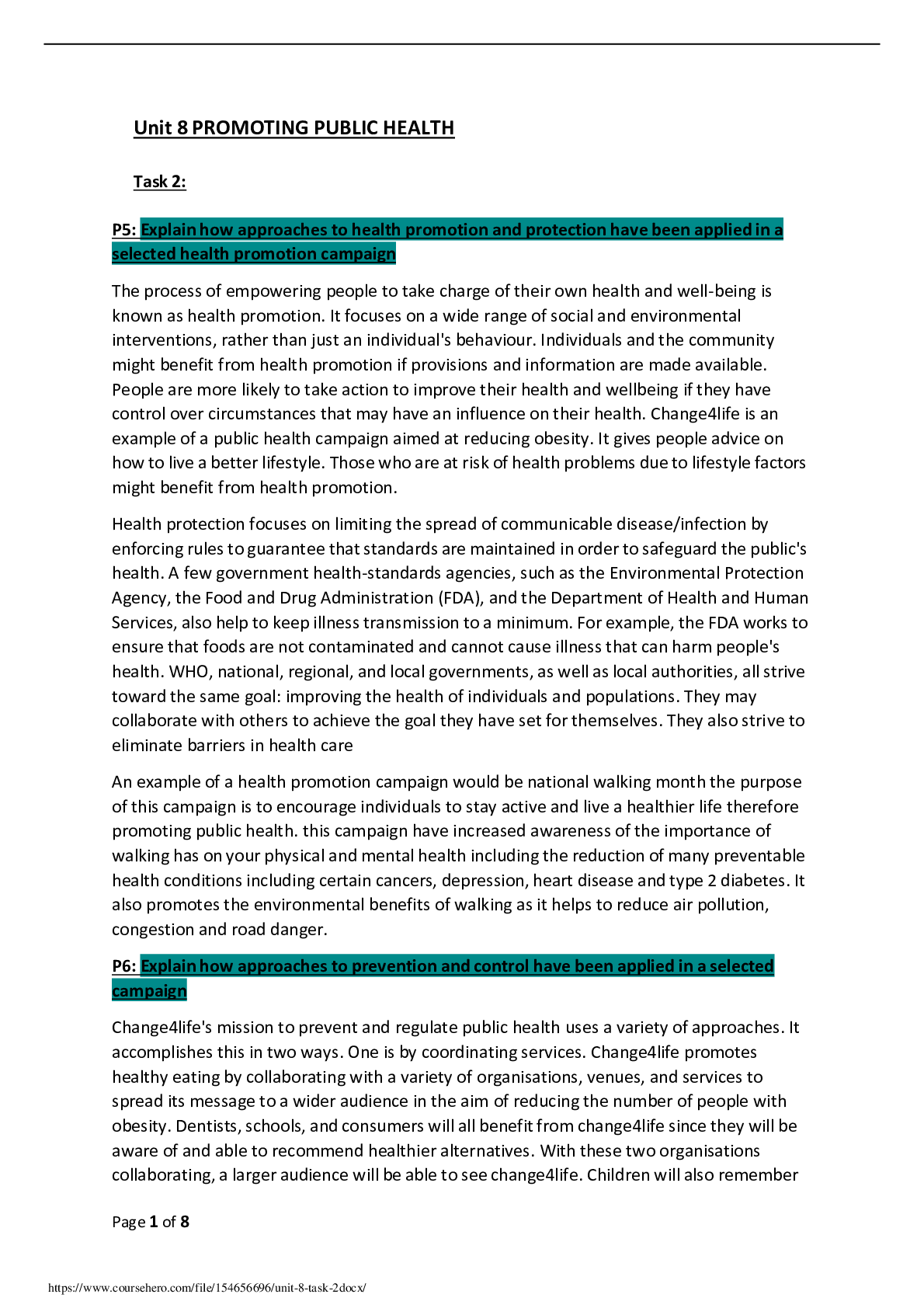
PROMOTING PUBLIC HEALTH
$ 9.5

NR 509 Week 2 Midweek Comprehension QUIZ Questions And Answers( Download To Score An A)
*NURSING > QUESTIONS & ANSWERS > Anatomy and physiology - EXAM 1, Q&A (2023 Update) (All)
basic functions of all living things - ANS--responsiveness -growth -reproduction -movement -metabolism anatomy - ANS-structure -cutting open study of the structure of the human body -external ... and internal -physical relationships between body parts physiology - ANS-study of function of anatomical structure -how organs work separate and together gross anatomy - ANS-include: -surface anatomy: what you can see on surface, study of general form and superficial markings -regional anatomy: study of all superficial and internal features of a specific region of the body systemic anatomy: study of the structure of major organ systems microscopic anatomy - ANS-includes: -cytology: study of cells -histology: study of tissues and organs under a microscope levels of organization ** - ANS--molecule-cell-tissue-organ-organ system- organism levels of organization : chemical level - ANS--Atoms are the smallest stable units of matter -Atoms combine to form molecules -Molecular shape defines function levels of organization : cellular level - ANS--Cells are the smallest living units -Cellular structures have specific functions -Different cell types have different functions levels of organization: tissue level - ANS--A collection of cells working together to perform a specific function -4 basic tissue types Epithelial, connective, muscle, and nervous tissues levels of organization: organ level - ANS-Organ: Two or more tissues working together to perform specific functions levels of organization: organ system level - ANS-Two or more organs working together to perform specific functions levels of organization: organism level - ANS-all organ systems working together to maintain health the integumentary system - ANS--skin -Protects against environmental hazards -Helps control body temperature -Sensory information the skeletal system - ANS--bones -Provides support -Protects tissues -Stores minerals -Forms blood cells -calcium is important for muscle function -body regulate Ca+ if not enough it will take from bones -axial skeleton: skull and ribs -appendicular skeleton: limbs the muscular system - ANS--Allows for movement -Provides protection and support -Produces heat when burning energy -skeletal voluntary muscle -muscle contract when cold "shivering" include: axial muscle, appendicular muscle, tendons the nervous system - ANS--Directs immediate responses to stimuli, usually by coordinating the activities of other organ systems -Provides and interprets sensory information -Cognitive functions -central nervous system: brain and spinal cord -peripheral nervous system: peripheral nerves the endocrine system - ANS--PRODUCE HORMONES -Directs long-term changes in activities of other organ systems -all endocrine glands pituitary gland - ANS-tell adrenal gland what to do, produce critical hormones paranthyroid gland - ANS-regulate calcium levels adrenal gland - ANS-produce hormones pineal gland - ANS-produce melatonin thyroid gland - ANS-metabolism , growth thymus - ANS-produce WBC pancreas - ANS-insulin and glucagon is reproduced regulate blood sugar helps in digestion the cardiovascular system - ANS-Transports cells and dissolved materials, including nutrients, wastes, and gases -carry blood: carry oxygen to tissues -heart, capillaries, artery , vein the lymphatic system - ANS--immune system -Defends against infection and disease; returns tissue fluid to the bloodstream lymph nodes - ANS-processing center for immune cells spleen - ANS-recycle RBC, fight bacteria the respiratory system - ANS--Delivers air to sites where gas exchange can occur -Produces sound -deliver air with oxygen -produce sound and sense of smell larynx - ANS-house vocal cords trachea - ANS-provide air flow bronchi - ANS-passageway to lungs the digestive system - ANS-Processes food and absorbs nutrients Continues... [Show More]
Last updated: 2 years ago
Preview 1 out of 42 pages
.png)
Buy this document to get the full access instantly
Instant Download Access after purchase
Buy NowInstant download
We Accept:

Can't find what you want? Try our AI powered Search
Connected school, study & course
About the document
Uploaded On
Feb 21, 2023
Number of pages
42
Written in
All
This document has been written for:
Uploaded
Feb 21, 2023
Downloads
0
Views
87
Scholarfriends.com Online Platform by Browsegrades Inc. 651N South Broad St, Middletown DE. United States.
We're available through e-mail, Twitter, Facebook, and live chat.
FAQ
Questions? Leave a message!
Copyright © Scholarfriends · High quality services·